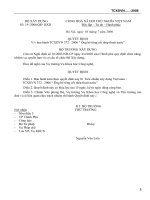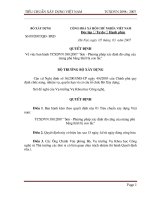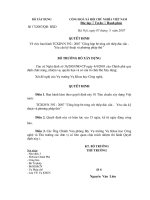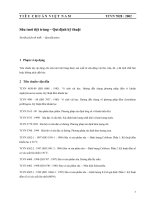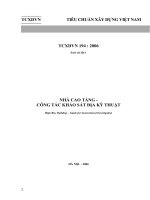Tài liệu TCXDVN 266 : 2002 ppt
Bạn đang xem bản rút gọn của tài liệu. Xem và tải ngay bản đầy đủ của tài liệu tại đây (153.95 KB, 34 trang )
TCXDN
vietnam construction standard
TCXDVN 266 : 2002
Residence - Guidance of accessible design and construction for People With
Disabilities
CONSTRUCTION PUBLISHING HOUSE
1
Hanoi - 2002
2
FOREWORD
The Standard TCXDVN 266:2002 is compiled on the basis of the Ordinance on
people with disabilities (PWD) :
Article 26.- “The investment for new construction or reconstruction of dwelling houses, of
public amenities and for design, manufacture of domestic furnitures, of transport and
communication means ... must take into account the needs for convenient use by PWD, firstly of
mobility and sight PWD, and at the same time have to comply with construction codes,
standards issued by competent state agencies”.
The Standard TCXDVN 266:2002 is compiled by the Research Institute for
Architecture and the panel for elaboration of “Codes and standards of
construction accessibility for people with disabilities in Vietnam”, submitted by
the Department of Science and Technology – Ministry of Construction, and
approved, signed, issued by the said ministry for enforcement.
The Standard TCXDVN 266 : 2002 is compiled with the cooperation and
funding by President’s Committee on Employment of People with Disabilities
(PCEPD) and Vietnam Assistance for the H andicapped (VNAH)
3
CONSTRUCTION STANDARD OF VIETNAM TCXDVN 266:2002
Residence - Guidance of accessible design and construction for people with disabilities (PWD)
1. Scope of application
This guidance is applied in the new construction of house/residence types ensuring the
accessibility and use by PWD in mobility and sight, and at the same time encouraged to
apply in the reconstruction/upgrade of old residential groups, taking into account the need
for use by PWD
2. Standards referred/cited
- Building code of construction accessibility for PWD
- TCVN 4451 :1987 - Residence - Basic rules for design
- TCXD 228 : 1998 - Walkway for PWD in facilities.
Part 1- Walkway for wheelchair users - Design requirements.
- TCXDVN 264 : 2002 - Buildings and facilities – Basic rules of accessible design
and construction for PWD.
3. Terminology, definition
Terminologies used in this guidance have been defined in the Building code of construction
accessibility for PWD.
4. Planning of residential quarter
4.1. The planning of residential construction for ensuring accessibility and use by PWD must
comply with the standard TCVN 4451:1987 - Residence - Basic rules for design.
4.2. Residences for ensuring accessibility and use by PWD are built at the following priority
locations:
- Locations convenient for transport, easily accessible by PWD;
- Locations close to parks, greenery, promenade ways;
- Locations close to commercial service centers, public service centers and health
care centers.
4.3. In residential quarters, it is necessary to design routes and sidewalks convenient for the use
of PWD. At entrance ways to residences, the sloping routes, sloping path to sidewalks for
PWD’s wheelchair must be arranged.
4.4. In residential quarters, signposts, guidance posters for PWD must be placed.
4.5. In designing residences for PWD, besides the compliance with requirements in this
guidance, designers must abide by regulations of the standard TCXDVN 264 : 2002 -
Buildings and facilities - Basic rules of accessible design and construction for PWD.
5. Design solutions
5.1. Car parking ground and car waiting spot
5.1.1. Car parking ground must comprise places for arranging PWD’s wheelchairs. The ratio of
places in car parking ground is as follows : for every 100 cars in general there must be 2
3 places for PWD’ vehicles. PWD’s vehicles must be arranged beside sloping way or at
the entry/exit path of buildings, with signpost, guidance poster, accordingly.
5.1.2. By the side of car parking ground there must be a clearance space for PWD on wheelchair
could ascend and get down. Width of clearance space: from 900mm to 1,200mm, in case
4
of bus, it must be 2,500mm (see fig. 1). But if it is arranged for two PWD’s to be parked
side by side, so it becomes possible to use a common path for wheelchairs.
5.1.3. At car waiting spots, sloping paths or sloping ways must be designed for PWP on
wheelchair could access to transport means. Car waiting spots must be lighted by at least
54 lux and have roofing. Details for design of sloping way, sloping path are in
accordance with regulations in article 5.2.
Sign post
Location
Fig.1. Dimensions prescribed for a car parking
5.2. Sloping way
5.2.1. Entry/exit ways of residence for ensuring accessibility and use by PWD must not have
brusque change in elevation, if there exist elevation change, it is necessary to design
sloping way. Sloping way for ensuring the use by PWD must be plane, unrugged and
with roughness.
5.2.2. Sloping ways of main entrance reserved to PWD on wheelchair comprise:
- Permissible slope from 1/10 to 1/33. Height and length of sloping of way are
shown in table 1.
- Width of sloping way must not be less than 1000mm. See fig 2, 3, 4.
- Arrangement of landing where length of sloping way exceed 9,000mm Length of
landing must not be less than 2,000mm and spaced by equal intervals not
exceeding 9,000mm (see fig 5 and fig 6)
- At two sides of sloping way, handrails must be arranged. Details for design of
handrail are shown in article 5.12
Note:
1) Where sloping way changes direction, L-shaped landing must be arranged, with each
side 2,000mm long.
2) Where sloping way has a slope exceeding 1/33, no need for arranging landing.
Table 1: Slope, height and length of sloping way (mm)
Slope of sloping way 1/10 1/12 1/14 1/19 1/20 1/33
Permissible height of each
flight of sloping way
600 750
Permissible length of each
flight of sloping way
6,000 9,000 12,000 14,000 14,000 25,000
5
Pedestrian path
Pedestrian path Ascending Pedestrian path
Fig 2: Perspective of sloping way (wide base)
Pedestrian path
Fig 3: Perspective of prolonged sloping way
Pedestrian path
Fig 4: Perspective of sloping way with continuous sidewalk
6
Fig 5: Lay out of sloping way outside buildings
Fig 6: Lay out of sloping way with landing in the corner
5.2.3. At the extremity and the end of sloping way, it must be a void space for wheelchair could
move, with dimension not less than 1,500mm.
5.2.4. It is necessary to arrange balustrade, handrails on both sides of the sloping way. Where in
a side of sloping way there is a void space, then under the balustrade, the handrail, it is
advisable to arrange safety edge with a height not less than 50mm, or to set up fence, see
fig 7.
5.2.5. Sloping way for blind persons has auxiliary low balustrade, with direction guiding slab
and indicating where are summit of sloping way, landing, waiting spot.
Fig 7: Safety balustrade of sloping way
5.3. Entry/exit way
5.3.1. In cases of residence where it is not possible to design sloping way, it is necessary to
design entry/exit way with steps for convenience to persons with difficult mobility such
as people on crutches, on stick and blind people. Entry/exit way with steps must ensure
following requirements :
- Permissible height of step : 120mm 160mm,
- Permissible width of step face : 250mm 400mm,
- Not using hollowed-out steps
7
- Arranging landing at highest step
- Where the stair comprises more than three steps, on two sides of the stair,
handrails must be arranged. Details for design of handrails are shown in article
5.12 (see fig. 8 and fig. 9)
Note : Regarding independently designed residences, it is permissible to design
hollowed out stair steps if so required.
5.3.2. Main entrance way to residence is arranged directly into the hall (unlikely to design
special way reserved to PWD). Main entrance way does not lead to bedrooms, and is
easily identified. There must be signposters, guidance posters.
5.3.3. Main entrance way must have same elevation with that of house floor, or there is a need
of sloping way into house floor.
8
1. Smallest dimension of void space
before the entrance way (1,500mm x
1,500mm); 2. Door of entrance way
arranged inside the wall; 3. Prolonged
handrail at the summit of sloping way;
4. Prolonged handrail at the bottom of
sloping way; 5. Access route with
steps; 6. Way margin; 7. Handrail
arranged at elevation 900mm; 8.
Sloping way with slope 1/12, width
1,200mm
Fig 8: Entrance way with steps
Fig 9: Crossing of stepped entrance way and sloping way
5.4. Hall
5.4.1. Main entrance way of residence must reach hall (for collective
residences), ante-room (for other residences). Staircase and lift are
arranged directly at hall.
5.4.2. Hall must have sufficiently wide dimension for wheelchair to move,
diameter 1,300mm. Anteroom is wide at least 2,300mm x 2,500mm.
Interval between two consecutive doors being 2,500mm, see fig 10.
5.4.3. Collective residences must have signposts and guidance posters at the
hall.
5.4.4. The surface of hall floor must be plane, with roughness, unslippery.
5.5. Corridor, walkway.
5.5.1. Clearance width of corridor is as follows:
- For 1 wheelchair to pass: not less than 1,000mm
- For 1 wheelchair and a pedestrian from opposite direction: not less
than 1,500mm
- For 2 wheelchairs to pass: not less than 1,800mm, see fig 11.
9
Fig 10: Mode of door arrangement at the hall and dimensions of hall space
Path for wheelchair Path for 2 wheelchairs Path for 1 wheelchair and 1 person
from opposite direction from opposite direction
Fig 11: Dimensions of various paths.
10
Fig 12: Width of direction changing corridor
5.5.2. At places where the corridor changes direction, the corridor must be
900mm wide, and if there is a door, the width thereof must be
1,200mm (see fig 12)
Fig 13: Direct entrance way at right angle
5.5.3. Where in two sides of corridor there is wall edge, then the clearance width
must be in accordance with regulation in clause 5.5.1.
5.5.4. Handrails in two sides of corridor must be at an elevation of 900mm.
Rotating angle at deviation points is preferably arched wall face or right
angled wall face.
Where there is difference in elevation at the extremity of corridor and the
end of corridor with floor surface or ground surface, it must be balustrade,
shielding plate or shielding edge, and there is a need for installation of
safety signpost.
5.5.5. Clearance dimensions for wheelchair moving in corridor are stipulated as
follows:
a) Direct, perpendicular entrance (see fig 13): clearance dimensions being
: 1,200mm x 900 mm
b) Parallel entrances (see fig 14) : clearance dimensions being 1,500mm
x 800mm
5.5.6. On walking way, it is permitted that objects could be protruded by 100mm
and installed at 600mm and over 2,000mm from floor surface (see fig.
15)
11
Note: Handrails of staircase and sloping way are permitted to protrude at
maximum 115mm.
5.5.7. Objects fastened on post such as advertisement posters, public telephone
poles, letter boxes.... are permitted to protrude 300mm in each side and
installed at an elevation of 600mm and over 2,000mm from the floor
surface (see fig 16)
Fig 14: Parallel entrances
Fig 15: Permissible limit of protruding objects
Fig 16: Permissible limit of protruding objects fastened on post
12
5.5.8. Where walkway has gradually lowered clearance height and less than
2,000mm, it is necessary to arrange shielding bars. Elevation for
installing shielding bars is at least 700mm from floor surface (see fig 17)
5.6. Staircase, up and down steps.
5.6.1. Stair cases in collective residence are regulated as follows:
- No use of arch shaped staircases, and spiralled ones;
- Width of staircase aisle not less than 1,200mm;
- Staircase surface being not slippery, and no square step toes.
Fig 17: Clearance height gradually lowered
- No use of hollowed out staircases
- Handrails must be arranged continuously, at an elevation of 900mm.
At the start and end points of staircase, handrail is prolonged by
300mm more. Details of handrail are regulated in article 5.12.
- If the staircase being covered by carpet, it must be firmly fastened.
The outer rim of carpet must be stuck on floor. The angle between
step face and step body must not exceed 30
0
. The step toe must not
be receding, thus entangling shoe caps or crutches.
Note: For dwelling houses such as attached houses, villas.... if required, it
is permissible for:
- Use of arch- shaped staircase, spiralled staircase;
- Width of stair aisle not less than 800mm.
5.6.2. Width of stair face must be not less than 300mm regarding in-door
staircase, not less than 400mm regarding out-door staircase. Height of
step must be not over 160mm regarding indoor staircase and not over
120mm regarding out-door staircase (see fig 18)
13
